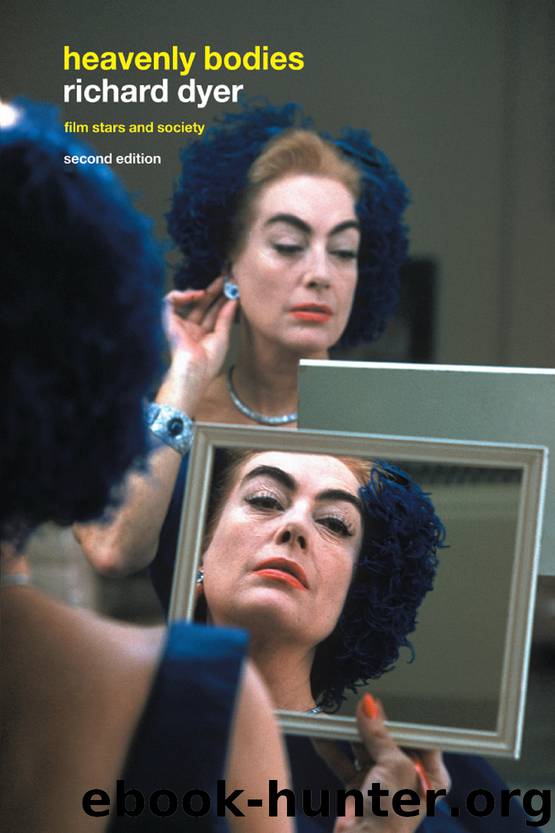Heavenly Bodies by Dyer Richard

Author:Dyer, Richard
Language: eng
Format: epub
Publisher: Taylor and Francis
FREEDOM
They are scared, Negro brother,
Our songs scare them, Robeson.
(Nazim Hikmet, ‘To Paul Robeson’)
So far I have been arguing that the conditions that made it possible for Robeson to be a cross-over star were his place in discourses of blackness that were acceptable to both black and white audiences, though they might be differently understood by those audiences. There is a price to be paid for success in these terms, and I have indicated how easily a positive view of black folk and African culture as a radical alternative to materialistic, rationalistic, alienated white Western culture slides back into sambo, Uncle Tom, brute and beast.
It is important to emphasise what nonetheless remains in the Robeson image, even when the sambo or brute imagery dominated it: a certain irreducible core of meanings that were still felt to be threatening or insolent or inspiring enough to need further ideological handling.
To begin with, a major emphasis of the image was always Robeson's physique, and the size and muscularity of this could easily be seen to be potentially at the service of the strength, power and action necessary for radical black advancement. Equally, his unassailable reputation as good, noble, pure, and so on, however much we may note in it notions of naivety and simplicity (and behind them childlikeness), was an image of what a black person could be and was, an image that still had that moral force in the face of racism which Stowe and others had intended it should have. Moreover, the extraordinary record of Robeson's achievement, outlined at the beginning of this chapter, meant that it was hard to deny what a black person was capable of doing – in sports, in the professions, academically and artistically.
More important still is the insistence on the concept of freedom throughout his work. I have noted above how the fact of slavery is to a considerable extent suppressed in Robeson's work. Although not altogether – it is still there in the play of The Emperor Jones; it is there obliquely in the words to ‘Old Man River’; it is there in the establishing sequence of Song of Freedom where John Zinga's ancestors flee the despotic queen Zinga unwittingly into the arms of the white slave trade.
Yet if direct acknowledgement of slavery is only to be found in these few examples, the implication of it and of white racism in general is continually present through the longing for and quest for freedom that runs through so much of his work. The song John Zinga carries in his (race) memory is not just any old song, but a song of freedom, giving its name to the film. Here, Africa connotes above all freedom, and, as Marion Berghahn (1977) has pointed out, this was characteristic of much black cultural production of the period, though seldom of white. At the beginning of Jericho (1937), Jericho/Robeson is unfairly sentenced to death for his necessary act of shooting a panic-stricken white sergeant when their ship was torpedoed; he escapes, to
Download
This site does not store any files on its server. We only index and link to content provided by other sites. Please contact the content providers to delete copyright contents if any and email us, we'll remove relevant links or contents immediately.
| Anthropology | Archaeology |
| Philosophy | Politics & Government |
| Social Sciences | Sociology |
| Women's Studies |
Cecilia; Or, Memoirs of an Heiress — Volume 1 by Fanny Burney(32436)
Cecilia; Or, Memoirs of an Heiress — Volume 2 by Fanny Burney(31872)
Cecilia; Or, Memoirs of an Heiress — Volume 3 by Fanny Burney(31857)
The Great Music City by Andrea Baker(31368)
We're Going to Need More Wine by Gabrielle Union(18970)
All the Missing Girls by Megan Miranda(15581)
Pimp by Iceberg Slim(14396)
Bombshells: Glamour Girls of a Lifetime by Sullivan Steve(13977)
Talking to Strangers by Malcolm Gladwell(13225)
Norse Mythology by Gaiman Neil(13209)
Fifty Shades Freed by E L James(13158)
For the Love of Europe by Rick Steves(13034)
Mindhunter: Inside the FBI's Elite Serial Crime Unit by John E. Douglas & Mark Olshaker(9206)
Crazy Rich Asians by Kevin Kwan(9170)
The Lost Art of Listening by Michael P. Nichols(7409)
Enlightenment Now: The Case for Reason, Science, Humanism, and Progress by Steven Pinker(7238)
The Four Agreements by Don Miguel Ruiz(6635)
Bad Blood by John Carreyrou(6553)
Weapons of Math Destruction by Cathy O'Neil(6147)
